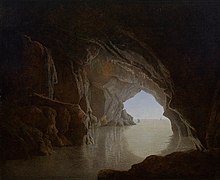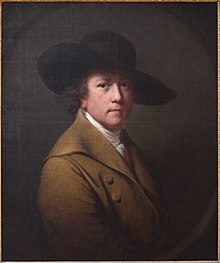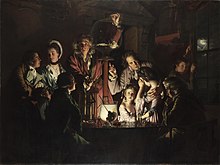Joseph Wright of Derby
Joseph Wright of Derby RA (born September 3, 1734 in Derby , † August 28, 1797 in Derby) was an English painter .
Life
Joseph Wright of Derby was born in Derby on September 3, 1734. He remained closely connected to his hometown throughout his life. His interest in the natural sciences became evident early on , as can be seen in his most famous works, such as B. "The experiment with a bird in an air pump". Above all these works established his fame, which took into account the beginning industrial revolution and the natural sciences. At the age of 17 (1751) Wright started his apprenticeship with Thomas Hudson , a prominent portrait painter. He adopted his portrait style. This was the first influence of a style neighbor. Now he began his career as a portrait painter.
In 1760 he traveled through Central England to get commissions there. He was disappointed with his first attempts at this subject. But over time he was well on his way to becoming a popular and well-known painter. But Wright soon set about working on a new type of image. He now painted pictures with natural-philosophical and scientific subjects, in which he experimented with special lighting effects. In his work with artificial and natural light, Wright received decisive impulses from the Caravaggists , especially the Dutch representatives of this style. He imitated light and dark painting.
plant

The 17th-century Dutch paintings that show alchemists in gloomy workshops are best seen as precursors to Wright's paintings. In 1772, just two years after Joseph Wright had painted the first of these pictures, fellow artist Joseph Northcote described him as the most famous living painter of "candlelight pictures ". The peculiarity of these pictures lies less in the effective lighting effects than in their subject matter. While the earliest candlelight pictures, also known as night pictures, show a figure or two in a dark room reading or looking at statues, Wright soon used such dramatic lighting for scientific subjects. With “A philosopher gives a lecture on the planetarium” and “ The experiment with a bird in an air pump ” Wright was the first English painter to create representations of contemporary natural sciences. The air pump picture consciously ties in with the worship scenes of the Caravaggists such as Hendrick ter Brugghen : the illuminated glass body is reminiscent of the Christ Child as the source of light.
In 1768 Wright went to Liverpool for three years, where he found many patrons who had themselves portrayed. One of them was Erasmus Darwin , the grandfather of Charles Darwin . He received a unique assignment from a certain Colonel Pale. Wright decorated an entire room in Radburne Hall with candlelight pictures .
In July 1773 the painter married Anne Swift. With her he then traveled to Rome . There he spent whole days doing watercolor studies based on Michelangelo's frescoes and copying ancient sculptures. These sketches were to serve as models for his life. The artist found a colorful source of inspiration for lighting effects in the grandiose fireworks in Rome. During a stay in Naples he witnessed an eruption of Mount Vesuvius . Wright recorded this natural event in a quick oil study. His later paintings already betray a romantic conception and point to the next generation of English landscape painters. Even before his return to England, Wright had turned increasingly to literary subjects.

Last years
In 1775 he returned to Derby. Less than two months later he moved to Bath to fill the void in portraiture left by his colleague Thomas Gainsborough . This calculation didn't work out. The genteel society was used to flattering, idealizing portraits and did not think much of Wright's rather sober portrait style, which had suited his patrons in Central England so well. He then returned to Derby for good, where he would eventually stay for the rest of his life. In 1784 he became a full member of the Royal Academy . There was a dispute with the institution. His friends were mainly people from the scientific field, whom he also portrayed, such as Thomas Gisbourne , Brooke Boothby and Jean-Jacques Rousseau . Wright suffered from hypochondria, rheumatism, asthma, and dropsy. Finally he died on August 28, 1797 in Derby.
Individual evidence
- ↑ Busch, p. 19 ff.
literature
- Werner Busch: Joseph Wright of Derby: The experiment with the air pump. Frankfurt 1986.
- Valerie Hammerbacher: Riot of the elements: the volcanic eruption. A study of motifs on the English natural aesthetics of the 18th century. Utz, Munich 2004, ISBN 3-8316-0366-9 .
Web links
- Literature by and about Joseph Wright of Derby in the catalog of the German National Library
- Joseph Wright at artfacts.net
- Joseph Wright of Derby at artcyclopedia.com (English)
- Selection of works at the BBC (English)
- Derby Museum and Art Gallery in Derby
- Selection of works at Tate Gallery (English)
| personal data | |
|---|---|
| SURNAME | Wright of Derby, Joseph |
| ALTERNATIVE NAMES | Wright, Joseph |
| BRIEF DESCRIPTION | British painter |
| DATE OF BIRTH | September 3, 1734 |
| PLACE OF BIRTH | Derby (Derbyshire) |
| DATE OF DEATH | August 28, 1797 |
| Place of death | Derby |

